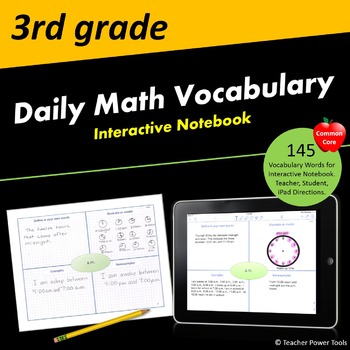Third Grade CCSS Math Vocabulary Interactive Notebook
Teacher Power Tools
17 Followers
Grade Levels
3rd
Subjects
Resource Type
Standards
CCSS3.MD.A.1
CCSS3.MD.A.2
CCSS3.MD.B.3
CCSS3.MD.B.4
CCSS3.MD.C.5
Formats Included
- Zip
Pages
169 pages
Teacher Power Tools
17 Followers
Description
Tired of your students mindlessly memorizing math vocabulary and then not applying it? Here's your solution! Rigor, collaboration, and differentiation are built-in components of this interactive journal.
This bundle includes everything you need for this year-long daily vocabulary notebook!
Comprehensive teacher instructions and lesson plans
Notebook labels
Specific directions for the students that can be displayed on the ActivBoard (Makes setting up the notebooks a breeze!)
Specific student directions for downloading the notebook into Notability
Grade level specific, comprehensive CCSS math vocabulary list (Covers all CCSS standards!)
Year-long daily vocabulary integrated into the research-based Frayer Model placed on grid paper (Have your students modeling math and communicating precisely with others.) (CCSS Math Practices MP4 and MP6)
Saves precious prep and classroom time! All of the words are there for you. Print 2 words/page, cut and distribute as part of your daily routine!
This bundle includes everything you need for this year-long daily vocabulary notebook!
Comprehensive teacher instructions and lesson plans
Notebook labels
Specific directions for the students that can be displayed on the ActivBoard (Makes setting up the notebooks a breeze!)
Specific student directions for downloading the notebook into Notability
Grade level specific, comprehensive CCSS math vocabulary list (Covers all CCSS standards!)
Year-long daily vocabulary integrated into the research-based Frayer Model placed on grid paper (Have your students modeling math and communicating precisely with others.) (CCSS Math Practices MP4 and MP6)
Saves precious prep and classroom time! All of the words are there for you. Print 2 words/page, cut and distribute as part of your daily routine!
Total Pages
169 pages
Answer Key
N/A
Teaching Duration
1 Year
Last updated Jul 15th, 2016
Report this resource to TPT
Reported resources will be reviewed by our team. Report this resource to let us know if this resource violates TPT’s content guidelines.
Standards
to see state-specific standards (only available in the US).
CCSS3.MD.A.1
Tell and write time to the nearest minute and measure time intervals in minutes. Solve word problems involving addition and subtraction of time intervals in minutes, e.g., by representing the problem on a number line diagram.
CCSS3.MD.A.2
Measure and estimate liquid volumes and masses of objects using standard units of grams (g), kilograms (kg), and liters (l). Add, subtract, multiply, or divide to solve one-step word problems involving masses or volumes that are given in the same units, e.g., by using drawings (such as a beaker with a measurement scale) to represent the problem.
CCSS3.MD.B.3
Draw a scaled picture graph and a scaled bar graph to represent a data set with several categories. Solve one- and two-step “how many more” and “how many less” problems using information presented in scaled bar graphs. For example, draw a bar graph in which each square in the bar graph might represent 5 pets.
CCSS3.MD.B.4
Generate measurement data by measuring lengths using rulers marked with halves and fourths of an inch. Show the data by making a line plot, where the horizontal scale is marked off in appropriate units-whole numbers, halves, or quarters.
CCSS3.MD.C.5
Recognize area as an attribute of plane figures and understand concepts of area measurement.


